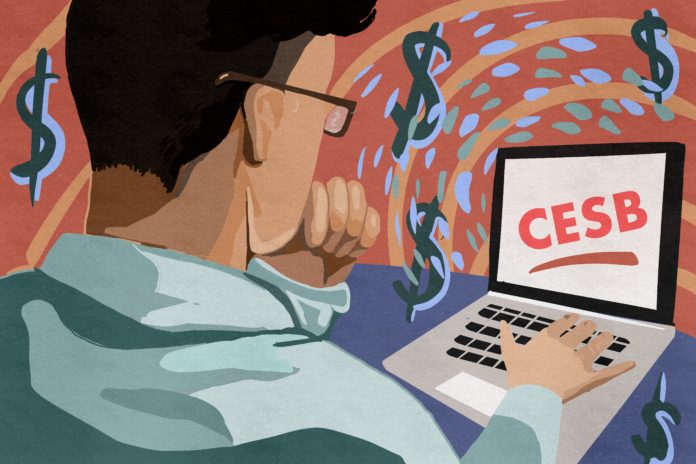Young Canadians are more likely to face financial hardship and dwindling job prospects in the wake of COVID-19, according to a recent Carleton University survey.
Published in May, the survey by four Carleton professors found that Canadians between the ages of 18 to 29 are more likely to face financial impacts than older respondents due to COVID-19.
Carleton professors Brett Popplewell, Josh Greenburg, Sarah Everts and Christopher Waddell worked in partnership with Abacus Data to field responses from over 2,000 participants.
The researchers tested for differences in the group including age, race, region, education, and political affiliation.
Seventy-seven per cent of respondents between 18 and 29 said that their family income has been reduced, compared to an average of sixty-two per cent of applicants who said the same.
“This makes sense that this age group, which would have less job security, has taken the brunt [and is] reporting the larger reductions,” Popplewell said.
Yuzana Wynn, a fourth-year kinesiology student at McMaster University, said she is one of the young Canadians affected.
“Like many students, I lost the opportunity to work at my part-time job and have had trouble finding job opportunities that are online,” Wynn said. “With [the] fall term online, I, along with many other students, are now tied down to leases that many landlords are unable to end or compensate for.”
This double financial blow is a reality for many students studying away from home. Thirty-three college and university campuses across Canada are now closed due to public health recommendations for social distancing.
A potential recession
“The Canadian economy is reeling, as the impacts of the COVID-19 pandemic ravage consumer and business spending,” the Canadian Outlook Economic Forecast said in its March 2020 release.
Many young people are now turning to Canada’s emergency benefits, such as the Canada Emergency Response Benefit (CERB), for financial support.
“My work laid off everybody, so I had to go on CERB,” Jai Gambhir, a chef in Toronto said. “As of right now, there are a lot of jobless chefs looking for a new job, so it’s very competitive.”
Although Canada has yet to experience a recession — two quarters of economic contraction — Canada is close to this economic downturn, according to the Economic Forecast.
“If there was a full-fledged recession, I feel like young people would be impacted a lot because recessions cause employers to lay off a lot of their people,” Oscar Alekseev, a third-year business student at Wilfrid Laurier University said.
Alekseev is also an associate analyst at Liberty Mutual Insurance. He has been working remotely since COVID-19 social distancing measures began.
“The office job I have right now isn’t very much impacted as far as hiring goes. Plus, the reason I have the job today is because of the co-op program at school,” Alekseev said. He is not worried about his job security for the time being.
Popplewell also said he remains hopeful in the face of a potential recession.
“I entered the workforce in a recession that was prolonged, and it created this scenario where it took longer for me to become a full-time permanent employee,” he said. “I would just suspect that this will be what happens here too.”
Popplewell said this economic shift may also amplify the idea of working from home.
Julia Zaharia, a second-year kinesiology student at York University, said that her transition to online schooling was smooth. “[There is] less time spent commuting, [and] time management is fully in my hands,” she said.
Reopening the economy
Given the disproportionate financial impact on young Canadians, Carleton’s survey also found young respondents were more eager to reopen the economy.
“I think [the economy] should reopen after the risk of getting COVID significantly decreases,” Gambhir said.
Ontario’s provincial government adopted a phased approach to reopening the economy. Phase one of reopening consists of opening a limited number of businesses, parks, and public spaces.
Phase two, which began Friday, consists of opening some services, office spaces, and retail workplaces, as well as increasing the gathering size to 10 people.
Phase three of Ontario’s plan to reopen will include opening all workplaces and loosening restrictions on public gatherings and social distancing.
Alekseev agrees with the phased approach to reopening since Canada took a phased approach to closing the economy in March.
“The last thing I want is for them to open it too early and get another wave of cases coming in,” he said.
Some other young people held different opinions on reopening.
Zaharia said that the economy should reopen as soon as possible. “Just looking at the number of deaths and those recovered, I believe this economic shutdown has been unnecessary,” she said.
In Carleton’s survey, respondents between 18 and 29 were 11 per cent more likely than those over 60 to say that social distancing measures should be lifted “immediately” — even if this leads to more COVID-19 cases.
“We found that younger Canadians were more bullish about the need to reopen the economy,” Popplewell said. “They were less inclined to say [the economy] should reopen when the public health officials say it’s safe.”
Young Canadians and the news
Canadians under 30 are more likely to believe conspiracy theories about COVID-19, such as the discredited theory that hydroxychloroquine could be used to prevent the virus, according to Carleton’s survey.
“Younger Canadians are significantly more reliant on Google and social media for their news, yet less inclined altogether to keep up with the daily news agenda as defined by more traditional news outlets,” Popplewell said.
Twenty-seven per cent of respondents between 18 and 29 said they keep up with the news every day.
This lower propensity to keep up with the daily news cycle is due, in part, to the statistical “fragmentation” of younger generations in how they access news, according to Popplewell. He said young people access their news from a larger variety of platforms, including social media, whereas larger groups of older Canadians are more likely to consume news from a smaller diversity of outlets.
Despite this, younger Canadians are still likely to subscribe to an online news site as a result of COVID-19.
“I spend several hours every day watching the news with my family. This has enhanced my understanding of COVID-19, not only regarding its financial impacts but also regarding its overall impacts on humanity,” Rachel Miller, a third-year psychology and linguistics student at the University of Ottawa said.
Waddell said that young Canadians’ likelihood to subscribe to an online news source gives him hope.
“That’s a potential bright spot for news organizations struggling to find new sources of revenue after the continuing collapse of advertising,” Waddell added.
Phase two
Phase one of this study was published on May 21, four days before George Floyd was murdered and worldwide protests against police brutality began.
While the initial survey results revealed the financial impacts of COVID-19, a second phase will begin this month where professors may ask participants about how current world events, such as Black Lives Matter protests, are further impacting them and their views on COVID-19.
“The onus is on us to make sure that the questions that we are asking [in phase two] serve both our purposes of gathering data that informs views about the pandemic, but also captures and helps our understanding of the moment in time that we are asking Canadians to respond to,” Popplewell said.
Some young Canadians agree that the Black Lives Matter protests will impact the number of COVID-19 cases, and most believe that these protests are very important, despite the potential risk.
“The issues surrounding the [Black Lives Matter] movement, such as racism and system injustices, also pose a health and safety risk to people, the same way COVID-19 does,” Wynn said. “Police brutality, lack of healthcare and limited opportunities for education for the Black community are just some of the many injustices that are prevalent today, and should also be considered a ‘virus’ to the Black community’s quality of life.”
Looking forward
The future is uncertain with respect to COVID-19, but there are some silver linings with respect to working from home.
“There might be more opportunities to work on projects that are not contained to where you are geographically,” Popplewell said.
Some students offered words of encouragement.
“Please reach out to your friends. Ask them how they are, and then ask a second time after they give you a three-word answer,” Miller said. “We need to take care of each other, and hold our loved ones metaphorically close.”
Featured image by Sarah Mizannojehdehi.






